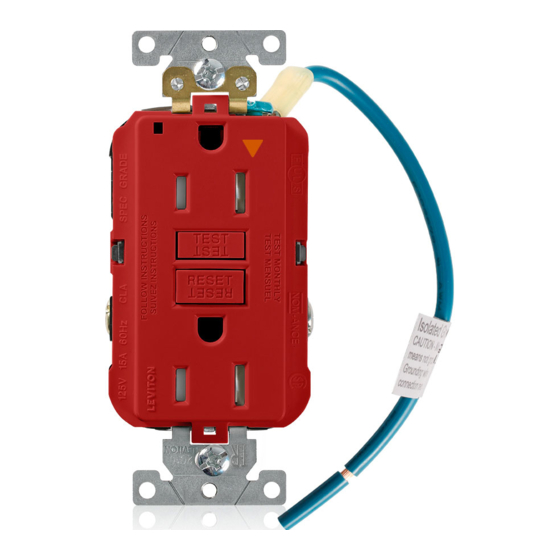
Advertisement
Quick Links
• To prevent severe shock or
electrocution always turn the power
OFF at the service panel before
working with wiring.
Installing and
• Use this GFCI with copper or
copper-clad wire. Do not use it
Testing a GFCI
with aluminum wire.
Receptacle
• Do not install this GFCI receptacle
on a circuit that powers life support
equipment because if the GFCI trips
it will shut down the equipment.
• For installation in wet locations,
Please read this leaflet
protect the GFCI receptacle with
completely before getting started.
a weatherproof cover that will
keep both the receptacle and
any plugs dry.
• Must be installed in accordance with
national and local electrical codes.
PK-A3275-10-00-2A
3. Should you install it?
4. LINE vs. LOAD
Installing a GFCI receptacle can be more
A cable consists of 2 or 3 wires.
complicated than installing a conventional
receptacle.
Make sure that you:
•
Understand basic wiring principles and
techniques
LINE cable:
•
Can interpret wiring diagrams
Delivers power from the service panel (breaker
panel or fuse box) to the GFCI. If there is only
•
Have circuit wiring experience
one cable entering the electrical box, it is the
•
Are prepared to take a few minutes to test
LINE cable. This cable should be connected to
your work, making sure that you have wired
the GFCI's LINE leads only.
the GFCI receptacle correctly
1. What is a GFCI?
!
CAUTION
A GFCI receptacle is different from
conventional receptacles. In the event of a
ground fault, a GFCI will trip and quickly stop
the flow of electricity to prevent serious injury.
Definition of a ground fault:
Instead of following its normal safe path,
electricity passes through a person's body to
reach the ground. For example, a defective
appliance can cause a ground fault.
A GFCI receptacle does NOT protect against
circuit overloads, short circuits, or shocks. For
example, you can still be shocked if you touch
bare wires while standing on a non-conducting
surface, such as a wood floor.
NOTE:
GFCI's contain a lockout feature that will
prevent RESET if:
•
There is no power being supplied to
the GFCI.
•
The GFCI is miswired due to reversal of
the LINE and LOAD leads.
•
The GFCI cannot pass its internal test,
indicating that it may not be able to provide
protection in the event of a ground fault.
5. Turn the power OFF
Plug an electrical device, such as a lamp or
radio, into the receptacle on which you are
working. Turn the lamp or radio ON. Then, go
Cable
Wires
to the service panel. Find the breaker or fuse
that protects that receptacle. Place the breaker
in the OFF position or completely remove the
fuse. The lamp or radio must turn OFF.
Next, plug in and turn ON the lamp or radio at
the receptacle's other outlet to make sure the
power is OFF at both outlets. If the power is not
OFF, stop work and call an electrician to
complete the installation.
2. The GFCI's features
FRONT VIEW
Receptacle
RESET
Outlet
button:
See step 8
RESET
TEST
TEST
button:
Outlet
See step 8
Self-Ground
Clip
Green/
Red
Mounting
Status
Bracket
Indicator
LED
6. Identify cables/wires
Important:
DO NOT install the GFCI receptacle in an
electrical box containing (a) more than four (4)
wires (not including the grounding wires) or
(b) cables with more than two (2) wires (not
including the grounding wire). Contact a
qualified electrician if (a) is true.
If you are replacing an old receptacle, pull it out
of the electrical box without disconnecting the
wires.
•
If you see one cable (2-3 wires), it is the
LINE cable. The receptacle is probably in the
position in the diagram to the right.
Remove the receptacle and go to step 7.
BACK VIEW
Grounding
lead (Green):
Connection for
LINE
bare copper or
White lead:
green wire
Connection
for the LINE
cable's
Neutral wire
LINE
Hot lead:
LINE/LIGNE
LINE/LIGNE
Connection
for the LINE
cable's Hot
wire
Sample circuit:
LINE
Service
Panel
Advertisement

Subscribe to Our Youtube Channel
Summary of Contents for Leviton SmartlockPro GFTR1-3L
- Page 1 1. What is a GFCI? 2. The GFCI's features CAUTION A GFCI receptacle is different from FRONT VIEW BACK VIEW conventional receptacles. In the event of a • To prevent severe shock or ground fault, a GFCI will trip and quickly stop electrocution always turn the power the flow of electricity to prevent serious injury.
- Page 2 LIMITED 2 YEAR WARRANTY AND EXCLUSIONS Leviton warrants to the original consumer purchaser and not for the benefit of anyone else that this product at the time of its sale by Leviton is free of defects in materials and Connect if no grounding wire: workmanship under normal and proper use for two years from the purchase date.















Need help?
Do you have a question about the SmartlockPro GFTR1-3L and is the answer not in the manual?
Questions and answers